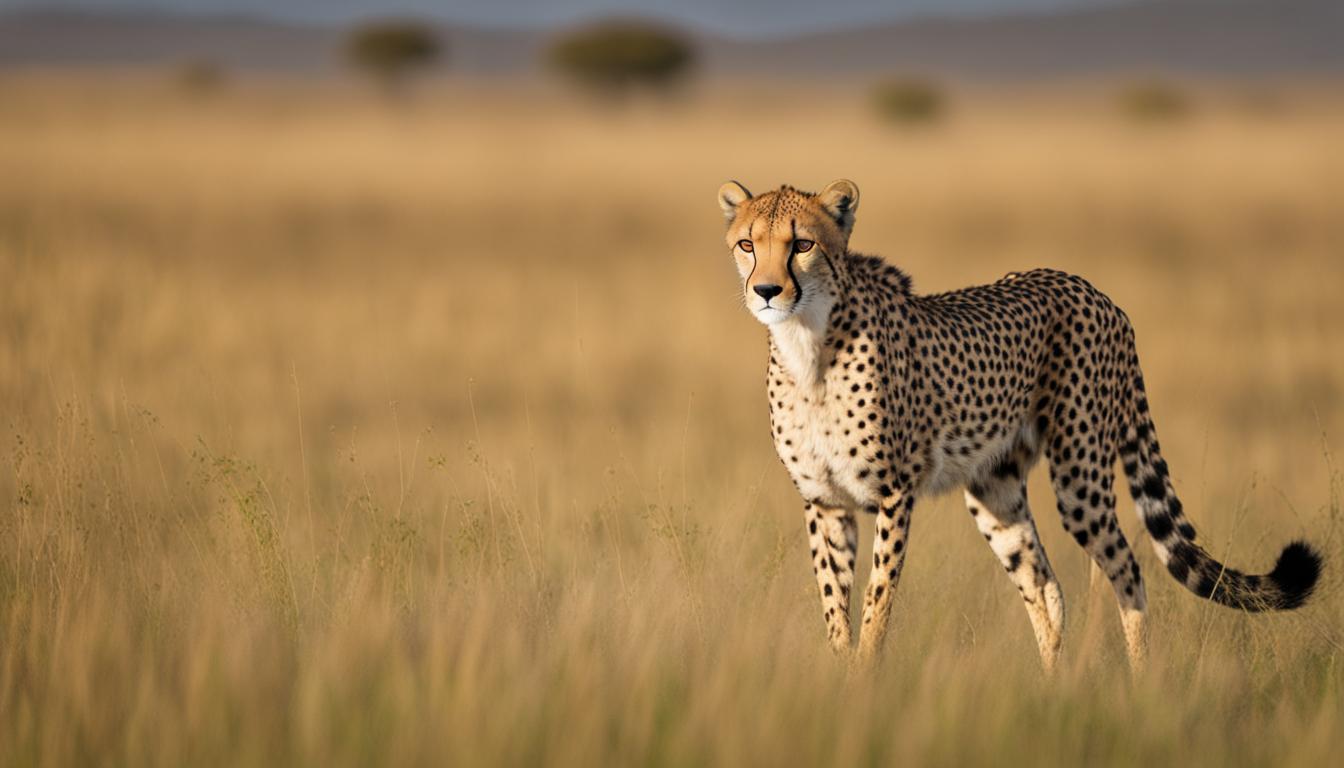When it comes to cheetahs, their behavior is fascinating to observe, whether they are in the wild or in captivity. Understanding their behavior is crucial for their survival and conservation. In this article, we will delve into various aspects of cheetah behavior, including hunting, diet, communication, socialization, territoriality, reproduction, and survival strategies.
Cheetahs are known for their incredible hunting prowess, using their speed and agility to chase down prey. Their hunting behavior is honed through years of evolution, making them one of the most efficient hunters in the animal kingdom. We will explore their hunting techniques and tactics, as well as their preferred diet.
Communication plays a vital role in the social dynamics of cheetahs. They have unique ways of vocalizing and using body language to convey messages to other cheetahs. We will uncover the intricacies of their communication methods and how it contributes to their socialization.
Cheetahs also exhibit territorial behavior, marking their territory to establish dominance and prevent conflicts. We will delve into their territoriality and how it influences their interactions with other cheetahs.
Reproduction is another aspect of cheetah behavior that we will explore. From mating rituals to raising cubs, we will uncover the remarkable strategies cheetahs employ to ensure the survival of their species.
Lastly, we will delve into the survival strategies cheetahs employ in the wild. Despite being swift and agile, cheetahs face numerous challenges that require them to adapt and develop strategies to thrive in their environment.
Throughout this article, we aim to provide valuable insights into the behavior of cheetahs, shedding light on their unique characteristics and highlighting the importance of conserving and protecting these magnificent creatures. Let’s embark on this journey to uncover the secrets of cheetah behavior together.
Physical Characteristics of Adult Cheetahs
Adult cheetahs possess distinctive physical characteristics that set them apart from other big cats. These elegant felines have a slender frame and weigh between 75 to 125 pounds. They measure approximately 40 to 60 inches in length from head to hindquarters, with an additional 24 to 32 inches contributed by their long, graceful tails. The cheetah’s body is built for speed, featuring a narrow waist, a deep chest, and long, agile legs.
A remarkable feature of adult cheetahs is their coat, adorned with solid black spots and tear stripes that run from their eyes to their mouth. These unique markings not only enhance their camouflage in their natural habitats but also serve as a visual means of communication. The tail of a cheetah ends with a bushy tuft and is encircled by dark rings, adding to its striking appearance.
Table: Average Physical Characteristics of Adult Cheetahs
| Weight Range | Length (head to hindquarters) | Tail Length | Distinctive Markings |
|---|---|---|---|
| 75-125 pounds | 40-60 inches | 24-32 inches | Solid black spots, tear stripes, tufted tail with rings |
The remarkable physical attributes of adult cheetahs contribute to their unmatched speed and agility. These characteristics, combined with their unique coat markings, make them truly fascinating creatures in the animal kingdom.
Built for Speed
Cheetahs are renowned for their incredible speed and agility, making them the fastest land animals on the planet. With a top speed of over 110 kilometers per hour (70 mph), they can accelerate from 0 to 60 mph in just a few seconds. This unparalleled speed is a result of their unique physical adaptations and specialized running techniques.
One of the key adaptations that enable cheetahs to achieve such remarkable speed is their flexible spine. Unlike other big cats, the cheetah’s spine is highly flexible, allowing for increased stride length and extension during the running motion. This flexibility enables cheetahs to cover more ground with each stride, maximizing their speed and efficiency.
In addition to their flexible spine, cheetahs have long, slender legs and a lightweight body, which further contributes to their impressive speed. Their legs are longer than those of other big cats, providing a greater stride length and allowing for more powerful strides. The reduced body weight minimizes drag and allows for quick acceleration.
Cheetah Stride Length
The cheetah’s stride length is another fascinating aspect of their running ability. With an average stride length of 6-7 meters, cheetahs are able to cover a significant distance with each step. This long stride allows them to maximize their speed while exerting minimal effort.
| Speed (km/h) | Stride Length (m) |
|---|---|
| 60 | 6.0 |
| 80 | 6.4 |
| 100 | 6.8 |
| 120 | 7.2 |
As cheetahs sprint at such high speeds, they can complete four strides per second, covering an impressive amount of ground in a short amount of time. This rapid stride frequency is a testament to their incredible running ability and their body’s ability to maintain stability and balance even at high speeds.
In conclusion, cheetahs are built for speed with their flexible spines, long legs, lightweight bodies, and impressive stride length. These adaptations allow them to reach astounding speeds and make them formidable hunters in the African savannah.

Cheetah Cubs
Cheetah cubs undergo a fascinating development process that shapes their behavior and prepares them for survival in the wild. From birth to adulthood, these adorable cubs demonstrate remarkable resilience and adaptability. Let’s explore the different stages of cheetah cub development, their behavior, survival tactics, and socialization.
Cub Development
At birth, cheetah cubs are blind and weigh between 8.5 to 15 ounces. They are entirely dependent on their mother for care and protection. Within a week, their eyes begin to open, allowing them to explore their surroundings. Over the next few months, the cubs grow rapidly, with their weight doubling or even tripling. By three months of age, they lose their distinct silvery-grey mantle and start to develop the iconic black spots seen on adult cheetahs.
Cub Behavior
Cheetah cubs are extremely playful and curious. They engage in mock fights, practice stalking, and pounce on anything that catches their attention, mimicking the hunting behaviors they will need to survive. These playful activities also strengthen their muscles and coordination. Cubs spend a significant amount of time grooming each other, which not only helps maintain cleanliness but also fosters social bonding within the litter.
Cub Survival and Socialization
The early months of a cheetah cub’s life are crucial for survival. They are vulnerable to predation, especially from larger carnivores like lions and hyenas. The mother cheetah plays a vital role in protecting her cubs, providing warmth, grooming, and teaching them essential life skills. At around six weeks of age, the cubs begin to follow their mother, learning hunting techniques, and observing her behavior. They gradually become more independent but remain with their mother until they are nearly full-grown, around 1.25 years old.
During this time, they learn to socialize with their siblings, developing communication skills and cooperation. These social interactions contribute to their overall survival and future success as adult cheetahs. By observing and practicing hunting techniques together, they improve their hunting proficiency and increase their chances of securing prey in the future.
The journey from tiny, helpless cubs to independent and skilled hunters is remarkable. Cheetah cubs not only survive but thrive in the wild, thanks to the guidance and protection provided by their mothers. Understanding their development, behavior, and socialization is crucial for ensuring the long-term conservation of these incredible creatures.
| Development Stage | Key Characteristics |
|---|---|
| Birth to 1 week | Blind, weigh 8.5-15 ounces |
| 1-3 months | Eyes open, weight doubles or triples, lose silvery-grey mantle |
| 3-6 months | Growth continues, playful behavior, start observing mother’s hunting techniques |
| 6-12 months | Increased independence, learn advanced hunting skills |
| 12-15 months | Nearly full-grown, start to separate from mother |

Social Behavior and Territoriality
Cheetahs are fascinating creatures when it comes to their social behavior. While most felids are solitary animals, cheetahs display a more social nature. Female cheetahs typically live alone with their offspring, while adult males have been observed forming coalition groups with their litter-mates. These male coalitions allow for increased protection and more successful hunting strategies.
Female cheetahs have larger home ranges compared to males, and territories can often overlap. This overlap can lead to conflicts between individuals, especially when it comes to defending resources such as food and shelter. Males will use scent marking and scent communication to establish and defend their territories, often leaving their mark on prominent landmarks within their range.
Mating in cheetahs is not predictable or regular, and females mate with multiple males during their estrus period. This behavior is known as polyandry and can help increase genetic diversity within the population. Male cheetahs will actively search for receptive females by analyzing their scent markings and vocalizations.
Cheetah Coalitions
One fascinating aspect of cheetah social behavior is the formation of male coalitions. These coalitions are typically made up of litter-mates and provide numerous advantages for the individuals involved. By hunting and defending their territory together, the coalition members increase their chances of survival and successful reproduction.
The formation and dynamics of male coalitions can vary, but typically consist of two to three brothers. These brothers will remain together for most of their lives, sharing the same territory and cooperating in hunting strategies. Cooperation between coalition members allows them to take down larger prey and defend their territory more effectively.
| Advantages of Male Coalitions | Examples |
|---|---|
| Increased hunting success | “The coalition members take turns chasing the prey, effectively exhausting it and increasing the chances of a successful kill.” |
| Protection against larger predators | “The coalition can effectively defend their territory against solitary intruders or larger predators like lions and hyenas.” |
| Increased chances of successful reproduction | “By cooperating in defense and hunting, the coalition members can secure resources and attract receptive females.” |
Overall, cheetah social behavior is a fascinating subject of study. Understanding their social dynamics, territorial behavior, and the formation of coalitions is crucial for the conservation and management of these magnificent animals.
Hunting Strategies and Behavior
The hunting behavior of cheetahs is a fascinating display of their exceptional speed and agility. Cheetahs rely on their keen eyesight to scan their surroundings from vantage points and identify potential prey. Once they spot a target, they employ stealth and patience to silently stalk their prey, getting as close as possible before initiating a high-speed chase. Cheetahs are known for their incredible acceleration, reaching speeds of over 70 mph in just a matter of seconds.
Cheetahs exhibit selective hunting tactics, preferring to target isolated individuals or young and vulnerable prey like fawns. This preference may be due to the reduced risk of injury during the chase, as well as the relative ease of capturing inexperienced prey. When the prey begins to run, the cheetah’s hunting behavior intensifies, triggering a powerful predatory instinct. Despite their remarkable speed, cheetahs lack endurance and can only maintain their top speed for short distances, typically within 20-30 seconds.
“The cheetah’s ability to accelerate rapidly and maneuver with agility during a chase is unparalleled in the animal kingdom. Their keen hunting strategies and lightning-fast speed make them formidable predators.”
Prey Selection and Hunting Success Rate
Cheetahs have a unique hunting style that is geared towards maximizing their chances of success. By targeting smaller and weaker prey, cheetahs minimize the risk of injury during the attack. Fawns, in particular, are a favorite prey choice due to their relative slowness and lack of experience.
When it comes to hunting success rates, cheetahs exhibit remarkable efficiency. Studies have shown that cheetahs have an average success rate of approximately 50% in their chases. However, when hunting fawns specifically, their success rate can be nearly 100%. This impressive success rate can be attributed to the combination of their exceptional speed and the vulnerability of young prey.
| Prey Selection Factors | Hunting Success Rate |
|---|---|
| Isolated individuals | High |
| Fawns | Nearly 100% |
| Adult prey | Varies |
Overall, the hunting strategies and behavior of cheetahs are perfectly adapted to their need for speed and efficiency. Their selective prey choices, lightning-fast acceleration, and high hunting success rates are a testament to their extraordinary hunting prowess.
Conclusion
Understanding cheetah behavior is crucial for the conservation and management of these magnificent creatures, whether in the wild or in captive environments such as zoos. Ongoing research on cheetah behavior, hunting strategies, social behavior, and territoriality plays a vital role in developing effective enrichment programs and conservation initiatives.
By gaining insights into cheetah behavior, we can create environments that promote the well-being and stimulate the natural instincts of these animals. Zoos, for example, can provide environmental enrichment by introducing smells that mimic the cheetah’s natural habitat, contributing to their physical and mental health.
However, it is important to remember that cheetah conservation extends beyond captive settings. Continued research and conservation efforts are crucial for the long-term survival of cheetah populations in their natural habitats. By studying cheetah behavior, we can better understand their needs and develop strategies to protect their habitats, reduce human-wildlife conflict, and ensure their continued existence.
Together, through research, enrichment, and conservation, we can help safeguard the future of cheetahs and ensure that these incredible animals continue to roam the wilds for generations to come.
What are the Differences in Territorial Behavior Between Wild and Captive Cheetahs?
Wild cheetahs exhibit natural cheetah territory establishment and defense behaviors, as they rely on large home ranges to hunt and breed. In contrast, captive cheetahs in zoos have limited space, so they may not display the same territorial behavior. Their feeding and mating needs are typically met without territorial defense.
FAQ
How do cheetahs behave in the wild and in captivity?
Cheetahs exhibit various behaviors such as hunting, socializing, marking territories, and reproductive strategies. In captivity, they may display different behaviors due to their environment and interactions with humans.
What are the physical characteristics of adult cheetahs?
Adult cheetahs weigh between 75-125 pounds and measure from 40-60 inches in length. They have a thin frame, deep chest, and distinctive markings including solid black spots and tear stripes. Their tails add an additional 24-32 inches to their overall length.
How are cheetahs built for speed?
Cheetahs have a flexible spine, long legs, lightweight body, specialized foot pads, claws, and muscles. These adaptations enable them to reach speeds of over 110 kilometers per hour (70 mph) in just a few seconds.
What is the development and behavior of cheetah cubs?
Cheetah cubs are born blind and weigh 8.5-15 ounces. They are dependent on their mother for care and learn essential life skills from her. They become more active and playful as they grow, and stay with their mother until they are almost full-grown.
What is the social behavior and territoriality of cheetahs?
Female cheetahs live alone with their offspring, while adult males may form coalition groups. Female cheetahs have larger home ranges than males, and territories can overlap. Mating in cheetahs is not predictable, and males use scent marking for territorial purposes.
What are the hunting strategies and behaviors of cheetahs?
Cheetahs hunt primarily by sight, utilizing vantage points to scan for prey and silently stalking their target. They prefer isolated individuals or fawns as their prey. Cheetahs have a success rate of about 50% in their chases, with nearly 100% success when hunting fawns.
What is the importance of understanding cheetah behavior for their conservation?
Understanding cheetah behavior contributes to creating effective enrichment programs and conservation initiatives. Research on their behavior aids in the maintenance of healthy and stimulating environments for cheetahs in captive settings. Continued research and conservation efforts are crucial for their long-term survival in the wild.










